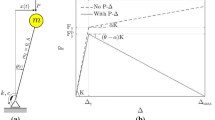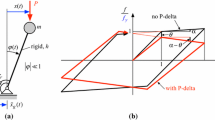Abstract
The main purpose of this paper is to study the collapse capacity of single degree of freedom (SDOF) systems and to produce fragility curves as well as collapse capacity spectra while considering a broad range of structural parameters, including system degradation, the P-Δ effect, ductility capacity and the post-capping stiffness ratio. The modified Ibarra-Krawinkler deterioration model was used to consider hysteretic behavior. A comprehensive study was conducted to extract the collapse capacity spectrum of SDOF systems with a wide range of periods, varying from 0.05 to 4 s, to cover short, intermediate and long periods. Incremental dynamic analysis (IDA) was performed for SDOF systems to identify the condition in which the collapse capacity of the system is determined. The IDAs were performed using different sets of seismic ground motions. The ground motion records were categorized into different sets based on three spectral shape parameters, including the epsilon, SaRatio and Np. The collapse fragility curves of SDOF systems with different periods were extracted to illustrate the collapse capacity at different probability levels. The results show that structural degradation and ductility as well as the spectral shape parameters significantly affect the collapse capacity of SDOF systems. On the other hand, the post-capping stiffness ratio and small levels of the P-Δ effect do not remarkably change collapse capacity. Also, the collapse capacity of SDOF systems is more sensitive to the records categorized based on SaRatio and Np than those classified based on epsilon.
Similar content being viewed by others
References
Abrahamson NA (1988), “Statistical Properties of Peak Ground Accelerations Recorded by the Smart 1 Array,” Bulletin of the Seismological Society of America, 78: 26–41.
Abrahamson NA (2000), “State of the Practice of Seismic Hazard Evaluation,” International Conference on Geotechnical and Geological Engineering, Melbourne, Australia.
Adam C (2008), “Global Collapse Capacity of Earthquake Excited Multi-Degree-of-Freedom Frame,” Workshop on Computational Mechanics of Materials and Structures, Taipei, Taiwan, China.
Adam C and Jäger C (2012a), “Seismic Collapse Capacity of Basic Inelastic Structures Vulnerable to the P-Delta Effect,” Earthquake Engineering and Structural Dynamics, 41: 775–793.
Adam C and Jäger C (2012b), “Simplified Collapse Capacity Assessment of Earthquake Excited Regular Frame Structures Vulnerable to P-Delta,” Engineering Structures, 44: 159–173.
ASCE/SEI 7–16 (2016), Minimum Design Loads and Associated Criteria for Buildings and Other Structures, Reston, Virginia, USA.
Baber T and Noori MN (1985), “Random Vibration of Degrading, Pinching Systems,” Journal of Engineering Mechanics, 111(8): 1010–1026.
Baker JW and Cornell CA (2005), “A Vector-Valued Ground Motion Intensity Measure Consisting of Spectral Acceleration and Epsilon,” Earthquake Engineering and Structural Dynamics, 34: 1193–1217.
Baker JW and Cornell CA (2006), “Spectral Shape, Epsilon and Record Selection,” Earthquake Engineering and Structural Dynamics, 34(10): 1193–1217.
Barkhordary M and Tariverdilo S (2011), “Vulnerability of Ordinary Moment Resistant Concrete Frames,” Earthquake Engineering and Engineering Vibration, 10(4): 519–533.
Bojórquez E and Iervolino I (2011), “Spectral Shape Proxies and Nonlinear Structural Response,” Soil Dynamics and Earthquake Engineering, 31(7): 996–1008.
Boore DM and Atkinson GM (2008), “Ground-Motion Prediction Equations for the Average Horizontal Component of PGA, PGV, and 5%-Damped PSA at Spectral Periods Between 0.01 s and 10.0 s,” Earthquake Spectra, 24(1): 99–138.
CEN (2003), Eurocode-8: “Design of Structures for Earthquake Resistance,” Part1, Pr-EN 1998-1, Final Draft. Brussels (BEL): European Committee for Standardization.
Clough RW and Johnston SB (1966), “Effect of Stiffness Degradation on Earthquake Ductility Requirements,” Second Japan National Conference on Earthquake Engineering, Tokyo, Japan.
Colangelo F (2008), “On the Computation of Seismic Fragility Curves,” The 14 World Conference on Earthquake Engineering, Beijing, China.
Eads L, Miranda E and Lignos D (2016), “Spectral Shape Metrics and Structural Collapse Potential,” Earthquake Engineering and Structural Dynamics, 45(10): 1643–1659.
Elnashai AS and Di Sarno L (2015), Fundamentals of Earthquake Engineering.
Haselton CB and Baker JW (2006), “Ground Motion Intensity Measures for Collapse Capacity Prediction: Choice of Optimal Spectral Period and Effect of Spectral Shape,” 8NCEE, San Francisco, California, USA.
Haselton CB and Deierlein G (2007), “Assessing Seismic Collapse Safety of Modern Reinforced Concrete Moment-Frame Buildings,” Department of Civil and Environmental Engineering, Stanford University, Report No. 156.
Ibarra LF and Krawinkler H (2005), “Global Collapse of Frame Structures Under Seismic Excitation,” The John A Blume Earthquake Engineering Research Center, Department of Civil and Environmental.
Ibarra LF, Medina RA and Krawinkler H (2005), “Hysteretic Models that Incorporate Strength and Stiffness Deterioration,” Earthquake Engineering and Structural Dynamics, 34: 1489–1511.
Jamshidiha H and Yakhchalian M (2019), “New Vector-Valued Intensity Measure for Predicting the Collapse Capacity of Steel Moment Resisting Frames with Viscous Dampers,” Soil Dynamics and Earthquake Engineering, 125: 105625.
Jouneghani HG and Haghollahi A (2020), “Assessing the Seismic Behavior of Steel Moment Frames Equipped by Elliptical Brace Through Incremental Dynamic Analysis (IDA),” Earthquake Engineering and Engineering Vibration, 19(2): 435–449.
Kircher CA, Reitherman RK, Whitman RV and Arnold C (1997), “Estimation of Earthquake Losses to Buildings,” Earthquake Spectra, 13(4): 703–720.
Kostov M (2000), “Seismic Fragility Analyses,” Regional Workshop on External Events PSA, Sofia, Bulgaria.
Lignos DG and Krawinkler H (2011), “Deterioration Modeling of Steel Components in Support of Collapse Prediction of Steel Moment Frames Under Earthquake Loading,” Journal of Structural Engineering, 11(137): 1291–1302.
Lignos D and Krawinkler H (2009), “Sidesway Collapse of Deteriorating Structural Systems Under Seismic Excitations,” The John A Blume Earthquake Engineering Center, Stanford Univ., Stanford, CA, USA.
MacRae GA (1994), “P-D Effects on Single-Degree-of-Freedom Structures,” Earthquake Spectra, 10(3): 539–568.
MATLAB (2014), The MathWorks, Inc. Retrieved from http://www.mathworks.de/de/help/ident/ref/goodnessoffit.html
Mousavi M, Ghafory-Ashtiany M and Azarbakht A (2011), “A New Indicator of Elastic Spectral Shape for the Reliable Selection of Ground Motion Records,” Earthquake Engineering and Structural Dynamics, 40(12): 1403–1416.
Newmark NM and Hall WJ (1982), Earthquake Spectra and Design, Berkeley, Calif: Earthquake Engineering Research Institute.
Norouzi A and Poursha M (2018), “The Collapse Period of Degrading SDOF Systems Considering a Broad Range of Structural Parameters,” Soil Dynamics and Earthquake Engineering, 115: 730–741.
OpenSees (2017), “Open System for Earthquake Engineering Simulation,” (Pacific Earthquake Engineering Research Center, University of California at Berkeley, Berkeley CA.) Retrieved from Pacific Earthquake Engineering Research Center, University of California at Berkeley, Berkeley CA.: http://opensees.berkeley.edu/.
Rahimi E and Estekanchi HE (2015), “Collapse Assessment of Steel Moment Frames Using Endurance Time Method,” Earthquake Engineering and Engineering Vibration, 14(2): 347–360.
Reinhorn AM, Barron-Corvera R and Ayala AG (2001), “Spectral Evaluation of Seismic Fragility of Structures,” Structural Safety and Reliability (ICOSSAR 2001), Corotis et al. Eds, Swets and Zeitlinger — Balkema Publishers.
Reinhorn AM, Madan A, Valles RE, Reichmann Y and Mander JB (1995), “Modeling of Masonry Infill Panels for Structural Analysis,” Technical Report NCEER-95-0018, Buffalo: State University of New York at Buffalo.
Shome N, Cornell CA, PB and Carballo JE (1998), “Earthquakes, Records, and Nonlinear Responses,” Earthquake Spectra, 14(3): 469–500.
Shu Z, Li S, Gao M and Yuan Z (2017), “Development of Seismic Collapse Capacity Spectra for Structures with Deteriorating Properties,” Earthquakes and Structures, 12(3): 297–307.
Sun C K, Berg GV and Hanson RD (1973), “Gravity-Effect on Single-Degree Inelastic System,” Journal of the Engineering Mechanics Division, 99(1): 183–200.
Tang B, Lu X, Ye L, Shi W (2011), “Evaluation of Collapse Resistance of RC Frame Structures for Chinese Schools in Seismic Design Categories B and C,” Earthquake Engineering and Engineering Vibration, 10(3): 369–377.
Tothong P and Luco N (2007), “Probabilistic Seismic Demand Analysis Using Advanced Ground Motion Intensity Measures,” Earthquake Engineering and Structural Dynamics, 36(13): 1837–1860.
Tsantaki S, Adam C and Ibarra LF (2017), “Intensity Measures that Reduce Collapse Capacity Dispersion of P-Delta Vulnerable Simple Systems,” Bulletin of Earthquake Engineering, 15: 1085–1109.
Tsantaki S, Wurzer L, Jäger C, Adam C and Oberguggenberger M (2015), “Refined Analytical Collapse Capacity Spectra,” IJST, Transactions of Civil Engineering, 39(C2): 253–270.
Vamvatsikos D and Cornell CA (2002), “Incremental Dynamic Analysis,” Earthquake Engineering and Structural Dynamics, 31(3): 491–514.
Vamvatsikos D and Cornell CA (2004), “Applied Incremental Dynamic Analysis,” Earthquake Spectra, 20(2): 523–553.
Yakhchalian M, Nicknam A and Gholamreza Ghodrati Amiri G (2015), “Optimal Vector-Valued Intensity Measure for Seismic Collapse Assessment of Structures,” Earthquake Engineering and Engineering Vibration, 14(1): 37–54.
Zareian F and Krawinkler H (2007), “Assessment of Probability of Collapse and Design for Collapse Safety,” Earthquake Engineering and Structural Dynamics, 36: 1901–1914.
Zareian F, Krawinkler H, Ibarra L and Dimitrois L (2010), “Basic Concepts and Performance Measures in Prediction of Collapse of Buildings Under Earthquake Ground Motions,” The Structural Design of Tall and Special Buildings, 19: 167–181.
Zarfam P and Mofid M (2011), “On the Modal Incremental Dynamic Analysis of Reinforced Concrete Structures, Using a Trilinear Idealization Model,” Engineering Structures, 33: 1117–1122.
Zentner I, Nadjarian A, Humbert N and Viallet E (2008), “Numerical Calculation of Fragility Curves for Probabilistic Seismic Risk Assessment,” The 14th World Conference on Earthquake Engineering, Beijing, China.
Author information
Authors and Affiliations
Corresponding author
Rights and permissions
About this article
Cite this article
Norouzi, A., Poursha, M. Effect of the spectral shape of ground motion records on the collapse fragility assessment of degrading SDOF systems. Earthq. Eng. Eng. Vib. 20, 925–941 (2021). https://doi.org/10.1007/s11803-021-2061-4
Received:
Accepted:
Published:
Issue Date:
DOI: https://doi.org/10.1007/s11803-021-2061-4




